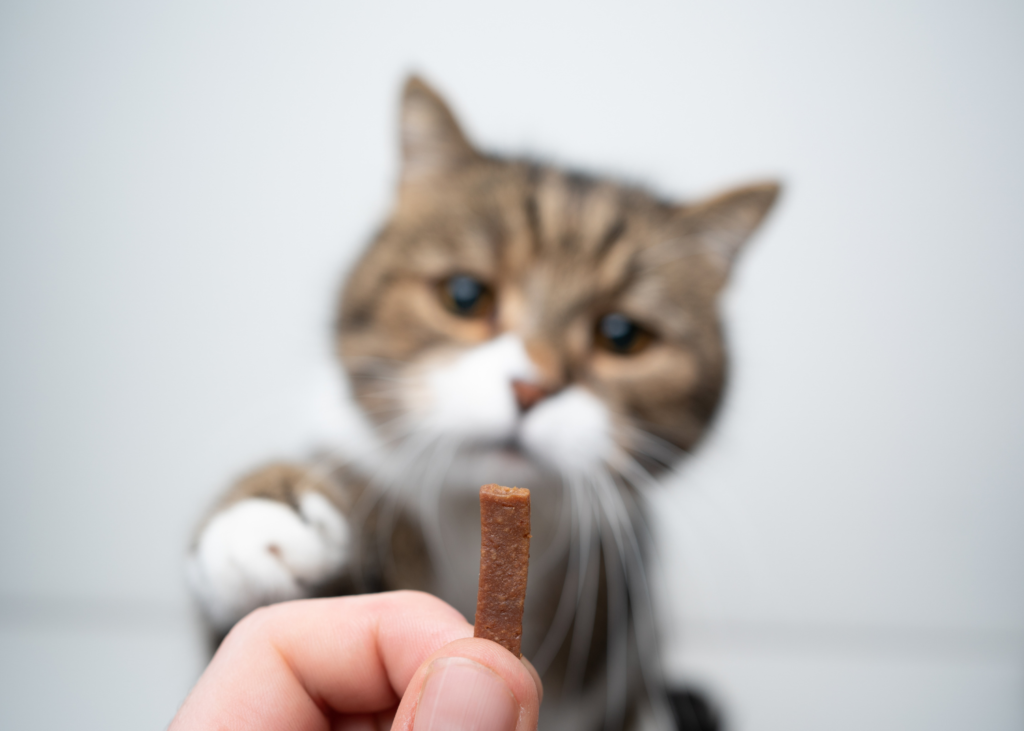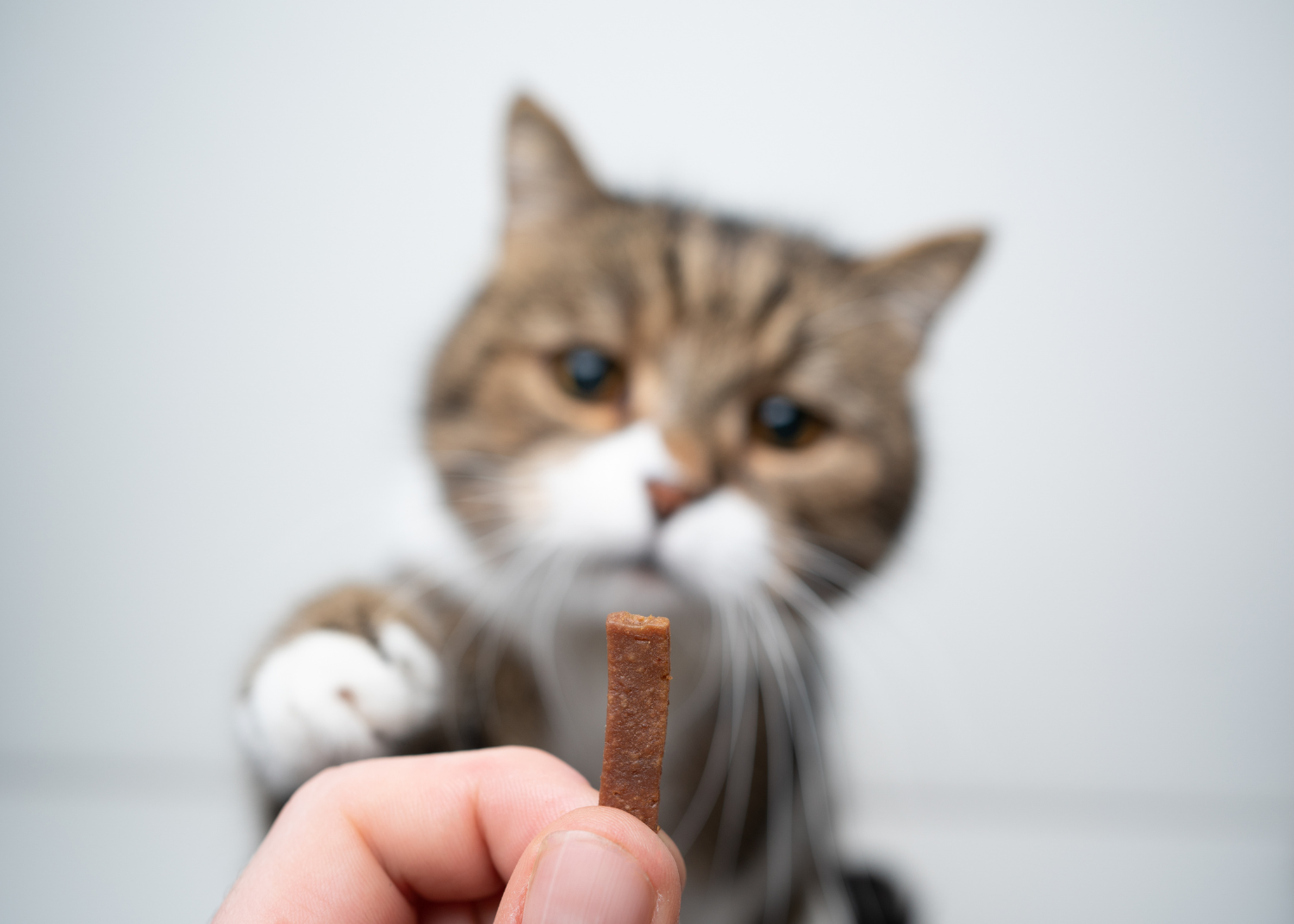How Do I Train My Cat Without Treats?
As more and more cat owners begin to consider their cat’s health, they might start to wonder:
- How do I train my cat without treats?
- Do I need treats to train my cat?
- Are there alternative ways to train cats that don’t require treats?
Some cat parents might be asking these questions because they’re worried about their feline friend gaining weight or they can’t find food their cat will work for.
If that’s you, keep reading because we’re going to share about other types of rewards (do they work?) and how to reduce your cat’s treat consumption.
Disclosure: Cat School may receive commissions from affiliate links included in this article.
Can I ever stop giving treats or rewards?
Rewards and positive reinforcement are necessary when you’re training your cat a new behavior or trick. But after your cat has mastered their behavior, you might be wondering if you can phase out the treats or rewards from your training sessions.
We’re going to answer that question with another question: Would you continue going to work without a paycheck? Probably not! We all need motivation to work hard, and cats are no different. While our paychecks come in the form of money, a cat’s best paycheck is usually in the form of food.
So what happens if your cat isn’t food motivated, or if you don’t want to use cat treats as rewards? Will praise, attention, or toys work instead?
Can I reward my cat with pats and praise?
Rewarding your cat with praise and attention might work in the short term, but if your goal is to teach a large repertoire of cat tricks and to work in distracting environments, praise and attention won’t get you very far.
Let’s go back to the work analogy… What if your boss only rewarded you for your work by patting you on the back and telling you what a great job you did? Chances are you wouldn’t stick around very long without an actual paycheck.
Can I reward my cat with toys?
Some cats are highly toy-motivated, so toys can work as training rewards. This is especially true if you’re working on a trick or behavior with motion, such as getting your cat to jump over your arm, leg, or another object. The reward would then be for your cat to chase their favorite toy. (Wand toys are great for this kind of training.)
One disadvantage to using toys for clicker training is that they can get your cat excited. If you’re working on a behavior that requires your cat to remain calm and stationary, it’s going to be harder to do that with toys.
Playing with a toy can also distract your cat from their training. It will take several seconds out of your training to play, as well as additional time to get your cat back into training mode.
In contrast, a tasty treat can be delivered to your cat in their current position and only takes a couple seconds to eat, allowing you to quickly move on to your next repetition. You will make much faster progress training with treats than with toys.

Increase Your Cat’s Food Motivation
If you struggle with finding a food or treat your cat will work for, you aren’t alone. The good news though is that there are ways we can work on building a cat’s food motivation and finding rewards they will work for.
If your cat doesn’t seem willing to work for food or treats, the issue generally lies with their diet. Here are a few changes you can make to help:
1. Don’t leave dry cat food out.
Leaving a bowl of dry food out for your cat to graze on all day will quickly ruin their food motivation. Dry food has a lot of flavors added to make it enticing for your cat, causing it to compete with your training treats and lowering the value of anything else you give your cat.
2. Feed your cat a moisture-rich diet.
To put it simply, wet food is healthier for your cat than dry food. Veterinarian and cat advocate Dr. Lynn Bahr of DeziRoo.com says that wet food is better for cats because it is lower in calories, higher in protein, and full of moisture.
Once your cat is on a wet food diet, you can reserve the highly-enticing dry food for training. Making this switch will fast-track your cat’s training because they already love their dry food. As long as you put it away and feed them something else for their meals, the dry food turns into an excellent reward.
If you’re still having trouble finding a treat your cat is willing to work for, read this article about what to do if your cat doesn’t like treats.
Reduce Your Cat’s Treat Consumption
Perhaps you’re worried about your cat gaining weight, or you’re on a budget and don’t want to have to buy a bunch of extra treats. No matter the reason, there are a few ways you can reduce your cat’s treat consumption:
1. Use their food as a reward instead of treats.
You don’t necessarily have to use treats as a training reward. You can use pieces of their dry food, and you can also use their wet food on a spoon.
2. Don’t reward every behavior.
Another way to reduce treat consumption is by not rewarding every good behavior or skill. In fact, it can even be better not to reward each time. Let’s use a slot machine analogy. If you go play a slot machine at a casino, you don’t win every round. You’re excited to keep playing though because of the opportunity to win.
This same principle can be applied to animal training. Our goal is for the cat to think they always have an opportunity to “win.” As long as they do, they will continue to work. You just need to make sure you reward your cat enough to stay motivated but not frustrated.
Note: If you click you must reward: one click = one treat.. If you aren’t rewarding your cat for every rep, be sure not to click.
3. Break treats into tiny pieces.
I often see people training with treats that are way too big. Guess what? Your cat will enjoy smaller treats too! Freeze-dried treats are especially easy to break apart into smaller pieces, plus they’re typically single-ingredient, making them a healthy treat option.
4. Deliver the food in a way that requires your cat to work to get it.
You can be savvy about your food delivery so your cat has to work a bit harder to get the treat. This strategy will help your cat get a bit more exercise as they work for their treats. A couple ways to do this include:
- Drop your cat’s favorite treat into a snuffle mat after they perform the desired behavior.
- Toss the treats away from you when you reward
- Build a chain of asking for several skills in a row before rewarding at the end. This is similar to a dog running an agility course before earning their reward at the end. You might ask your cat to jump on a chair, spin, jump off and over an obstacle and only reward the final jump.
While praise and toys can work for cat training in some instances, food rewards really are the best and most effective. As you can see, there are ways you can learn how to use food and treats properly so you aren’t giving your cat anything unhealthy or causing them to gain weight.
Watch this Cat School video for more info about alternatives to training treats and ways to reduce your cat’s treat consumption:

